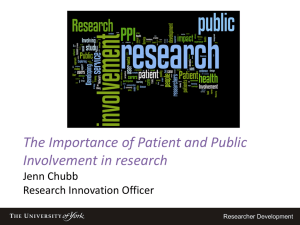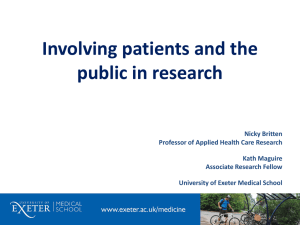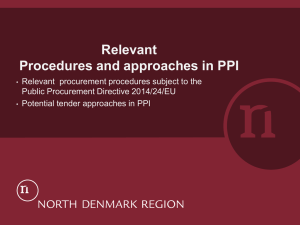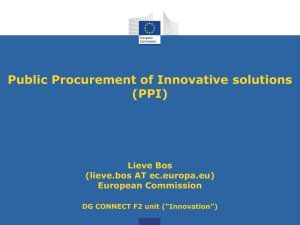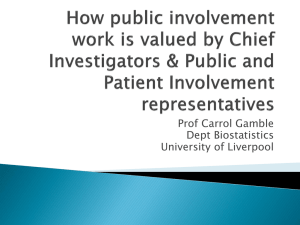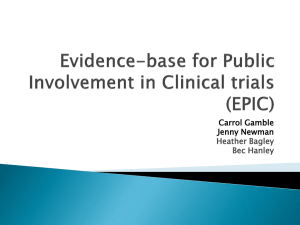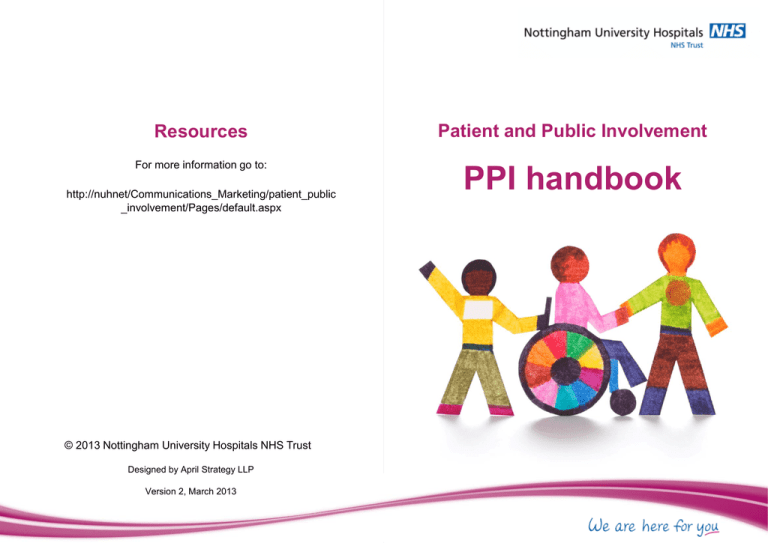
Resources
Patient and Public Involvement
For more information go to:
PPI handbook
http://nuhnet/Communications_Marketing/patient_public
_involvement/Pages/default.aspx
© 2013 Nottingham University Hospitals NHS Trust
Designed by April Strategy LLP
Version 2, March 2013
Contents
NUH Patient and Public Involvement (PPI) toolkit
2
What is PPI?
p4
Why carry out PPI?
p6
Planning for success
p8
The PPI cycle: four types of activity
p10
A. Patient needs and views
p12
B. Participation and co-design
p20
C. Partnership in running services
p28
D. Planning and monitoring
p36
Involving seldom heard and diverse
minority groups
p44
Notes for facilitators
p46
Checklist
p48
Recording and reporting
p50
Foreword
Our commitment to our patients
is to provide caring, safe,
thoughtful and
effective care. We have
made a promise to patients that
‘we are here for you’.
In making this a reality every
day, for every one of our
patients it is essential that
patient and public opinion is
heard, feedback is acted on,
and lessons are learned.
Chief Executive,
Nottingham University
Hospitals NHS Trust
This toolkit has been developed
to help staff to listen to and
involve their patients in
improving
services, because patientcentred care is more
effective care.
3
What is PPI?
What is Patient and Public Involvement?
PPI activities already in action
PPI means putting patients and the public at the centre of all that
we do. This means involving patients or the public to:
There is already a well-developed range of PPI activities and
information available for you to access, both in our Trust and
other local NHS organisations.
• Let us know about their needs and experiences
• Identify what they want from services
• Share their ideas and get involved in service design
• Have a say how services and plans are delivered
• Understand our plans and why services need to change
• Tell us how we are doing in delivering our promises
• Involving people in decisions about their treatment
• Understand what’s going well that we can do more of
PPI helps us to be ‘here for you’
Our promise to patients of Nottingham University Hospitals (NUH)
is that ‘we are here for you’. We promise patients that they will
feel cared for, feel safe, feel confident in their treatment and feel
that services are getting better.
PPI is about listening to and involving patients and the public, so
we can understand how we can best serve their needs as
individuals. It helps us to be ‘here for you’ in ways they want.
4
In this document term ‘patients and public’ encompasses
patients, carers, service users, individuals, groups and
communities. Depending on what we are looking to achieve we
may involve different people or groups at different times.
PPI activities already in action
•
•
•
•
•
•
Our 10,000 Foundation Trust public members are keen to tell
us what they think about our services and plans. We have a
regular programme of members’ events
Our readers’ panel advises us on patient information leaflets
and other publications
Our Patient Partnership Group meets monthly and can
comment on services, provide ‘observations of care’ (see
p. 40), or can advise on other PPI activities
We have a new Young People’s Forum
We work closely with LINks (local involvement networks) and
patient support groups
We attend local community events and residents’ forums
Listening to patients’ experiences of care
•
•
•
•
We use patient opinion trackers to understand patients’
experience of our services. We have a monthly Trust-wide
inpatient survey and one-off surveys for specific services
We train volunteers to undertake ‘observations of care’
There are annual national inpatient surveys and other surveys
that measure patients’ views on outpatient, maternity, cancer,
paediatric and emergency services
There are processes to manage and learn from patient
complaints, concerns, comments or compliments
5
Why involve patients and the public?
Why should we do PPI?
PPI is everybody’s job
PPI is about understanding and valuing the benefits of involving
patients, visitors, carers and other members of the public in the
planning, development, day-to-day delivery and evaluation of
health services.
As healthcare workers we are all committed to improving the
health and well being of the people we care for. Involving patients
in improving services is just as much as part of our jobs as
delivering our professional roles. Our Trust-wide Values and
Behaviours state that:
Effective PPI can improve patient care. By engaging with the
needs and views of the people who use our services, we ensure
they are at the heart of our decision making.
What benefits can you expect?
• By listening to patient views: we can learn about their needs
and experiences and identify specific areas for improvement
•
•
•
By involving patients in service design: we can ensure that
our services are designed and adapted to respond better to
the needs of individual patients and patient groups
By running services in partnership with patients: we keep
patients’ needs at the forefront of every decision we make,
and allow alternative proposals to be developed
By measuring how we are doing: we can see how our
improvement plans and activities are progressing
•
•
6
We can start by listening to patients
This toolkit has been introduced to help build confidence and
capacity for Patient and Public Involvement across our
services. It will not give you all the answers when it comes to
liaising the patients carers and the wider public. But it can help
you focus on why you should involve the people who use your
services, and offer a range of methods and approaches to use
in certain situations.
PPI is a legal requirement too
Under section 242(1) of NHS Act 2006 as amended by the local
government and public involvement in Health act 2007, NHS
organisations are required to consult and involve patients and the
public:
•
By involving front-line staff in PPI, we can help them put
themselves in patients’ shoes, reminding them that people
should be allowed to influence their own care, and help them
deliver care that is more consistently patient-centered.
Continually improving for patients is everybody’s role
•
•
Not just when a major change is proposed but in the ongoing
planning of services
When developing, as well as considering, proposals
In decisions that may affect the operation of services
7
Planning for success
Questions to consider when planning PPI
The following questions can help you to plan for successful
patient and public involvement:
Why use patient and public involvement?
• What do you hope to achieve by involving patients, carers and
the wider public in a particular piece of work?
• Is everyone who needs to be clear about the objectives?
What do you want from patients and the public?
• What level of involvement are you asking from them? Are you
looking to understand their needs, to involve them in designing
services, to get their feedback to proposals, or to measure how
you are doing in delivering improvements?
• Are you clear about which approach to use and why?
Who should you involve?
• Which groups of people should we engage in your PPI?
• Do you need their consent to present their stories?
• Do you need to listen to any seldom-heard groups?
• How will you recruit people (complaints, flyers, groups?)
How will you use their views and opinions?
• How are you going to analyse and present your findings?
• Which groups of people will you share the outcomes with?
• How will the views of patients and the public influence your
discussions and decisions about planning and services?
8
How will you let participants know the outcome?
• How do you plan to feedback to the individuals who have taken
part and to the broader public and colleagues?
Establish a planning team
Bring together a small team of people to plan
the exercise, set objectives and be clear
about how the PPI is going to affect the
service and influence decision-making.
Answer key questions
•
•
•
•
•
•
What information is required?
How will the information be used?
What resources are available
Who will you involve
What method will you use
How will you prepare for the activity?
Chose the right approach
This should match the purpose and target audience. Check
first if the information is available from current PPI activities.
Develop and communicate your plans
Plan your activity in detail. Plan to
communicate to all those involved.
Report and evaluation
Consider and plan in advance how you
will report and evaluate the activity.
9
The PPI cycle
Four types of PPI activity
We can use PPI across a the life-cycle of service improvement
and delivery, from listening to patients views, involving them in
designing service improvements, acting as partners in oversight of
service delivery, and measuring how we are doing to identify new
areas where improvement is needed.
A. Patient needs and views
Getting new insight into the needs, views and experiences of
the people we serve:
1. Patient stories
2. Focus groups and discussions
3. One-to-one interviews
B. Participation and co-design
Involving patients and the public in designing service
improvements and making strategic decisions:
1. In your shoes
2. Experience-based design
3. Informal consultation meetings
C. Partnership in running services
Types
of PPI
Giving communities a say in running our services:
1. User and community groups
2. Patient champions
3. Carer groups
D. Planning and monitoring
Checking how we are doing and where to focus improvement
efforts:
1. Surveys
2. Observations during care and treatment
3. Recording and action planning
10
11
A. Patient needs and views
What’s in this section?
This includes approaches that can help us to gain
insight into the needs, views and experiences
of the people we provide a service to:
1.
Patient stories: to inspire and motivate change
2.
Focus groups: to explore an issue in detail
3.
One-to-one interviews: to gain insight from a broader
cross section of the population
When should you use these approaches?
•
•
12
When you are looking to understand where to focus
your improvement efforts
To identify specific aspects of your service that work
well to build on, or that doesn’t work so well we need
to think about doing differently
•
To inspire front line teams by seeing that patients’
and carers’ points of view are often
very different to their own
•
Hear about what’s gone well to give positive
feedback to frontline teams
13
A1. Patient stories
When is this approach helpful?
Typical approach
Stories are a powerful way to bring patients’ views into the
organisation. They can help by reminding us to put ourselves in
patients’ shoes, and that often the things professionals think are
important are not high on the patient’s agenda.
The key to successful patient stories is to follow the patient’s
lead, at their pace, listening carefully all the time.
Ask for a summary of the issue
and the service the patient
used.
Stories can either be recorded beforehand as documents, audio
or video; or patients can tell their story in person.
Planning guide
Be clear about objectives. Do you want to remind a meeting of
the need to be patient-centred, or do you need to bring to life
specific patient needs to inspire service improvement.
Set the scene
Agree patient selection criteria, for stories that create the desired
impact, and to ensure you hear from diverse voices.
What happened?
Confirm attendance and gain the patient’s consent to use their
name, photo and story in internal documents (use the consent
form on the PPI resources section of the intranet)
How did you feel?
Agree how to deal with any personnel issues that come up.
Listen to the patient by asking open questions, trying not to
‘justify’ or ‘yes but’, and giving them time and space to speak.
Feedback what you heard and what you changed as a result.
Hints and tips
14
Topics to cover
• Be sensitive to peoples’ emotions. Walk in their shoes
• In reliving their experiences patients can feel strong
emotions and may need your empathy and support
• Feedback positives as well as issues to frontline teams
What did you want
to happen?
What could we do
differently?
Allow the patient to start the
story where they want to, but try
to cover their whole patient
journey:
• How did you access the
service?
• What info were you given?
• What happened as you
arrived?
• What happened at each stage?
• Howout
were
youthe
kept
informed?
Find
about
impact
of our
service
on the patient
byend?
asking
• What happened
at the
‘how did this make you feel?’
It’s difficult for patients to know
what’s possible, but they can talk
about their ideals. Ask them what
they would have wanted to
happen.
Review each step of the story
and think of practical ideas
about how we could have made
it better.
15
A2. Focus groups
When is this approach helpful?
Typical approach
Focus groups are a good way to explore issues in depth and
to get qualitative information about patient needs and views.
Groups are often focused around people of similar age,
gender, race or experience. You can use them to explore
issues or topics in more detail than with other approaches.
You can either discuss your list of six to eight primary questions
one-by-one, or have participants set the agenda, as shown
here.
Introduce yourself, objectives and
ground rules (e.g. confidentiality).
Planning guide
Clarify your objectives: how will the output be used, what do you
already know, what new information do you need?
Arrange participants. Focus groups work best with around
six people of similar age, gender and beliefs. Invite people who
have made complaints or accessed PALS, or hand out flyers. The
discussion could take place as part of an existing group.
Ground rules (10m)
Introductions (15m)
Arrange a venue: e.g. a comfortable community setting.
Headlines (30m)
Plan the discussion guide, with a list of six to eight primary
questions you would like answers to, and secondary questions to
probe people’s responses to primary questions.
Focus (30 - 60m)
Refresh yourself on the role of the facilitator, which is to help
people express their views, without judging.
Feedback what you heard and what you changed as a result.
Hints and tips
16
Focus group agenda
• You could ask an independent person from another service to
run your focus group, and offer to run one for them
• Tape record the session, or ask a colleague to take notes
• If one person dominates the discussion, thank them for their
energy, and ask to hear from others
Thank you (5m)
Each person introduces and says
a bit about themselves and this
topic.
Ask people to jot down headlines
of two or three issues that are
most important to them. Go round
the room, each person raising one
topic and discuss for five minutes.
Ask ‘why is this important’, and
‘who else had something like
this’?
When everybody has spoken
agree three issues to discuss in
detail.
Raise your questions if they were
Discuss
views
each issue
not
included
in about
participants’
lists.
in turn. Ask ‘what experience do
you have of this?’ Probe: ‘could
you tell me a bit more about
that?’, ‘how does that work in
practice?’, or ‘can you give me
an example?’
Make sure everyone who wants
to speak has been heard.
17
A3. One-to-one interviews
When is this approach helpful?
Typical approach
One-to-one interviews are helpful in gaining insight from a broad
cross-section of people. Semi-structured interviews aim to explore
an issue in detail, while structured interviews are less flexible but
useful in gaining qualitative feedback on an issue or service, and
to get insight into sensitive issues.
Interviews should follow a clear pattern, so participants feel
comfortable.
Thank you, the interview will
take x minutes, it is confidential
so please be as open as you
Semi-structured 1:1s
can.
Introduce each topic: ‘Can you tell
me what your experience has
Introductions
been of this topic? Probe: ‘can
you tell me a little more about
that’, ‘can you give me an
Attitudes
example’.
‘Laddering’ can help probe into
people’s views and motivations
Reasons
by asking ‘why do you think that?’
or ‘what makes you say that?’
Planning guide
Set objectives: what will the insight be used for? Do you need
qualitative information to inform your planning, or quantitative data
to help you make decisions?
Agree who you want to hear from – 1:1’s can reach a range of
groups, using interviewers who speak different languages.
Choose the medium: consider the advantages of telephone
(cost, reach) or face-to-face interviews (rapport, depth).
Carefully plan the discussion topics and questions. For semistructured interviews follow similar guidelines to focus groups,
ensuring questions are not prescriptive. Structured 1:1’s need a
balanced of open and quantitative questions.
Choose the interviewer who can be from outside the service if
you are looking for an independent view.
Pilot and refine the questions before finalising.
Prioritising
Structured 1:1s
Introductions
Quantitative attitudes
Compile a spreadsheet of interviewees, times and venues.
Qualitative reasons
Hints and tips
‘Of all we have talked about,
what’s most important, and why?
Thank you, length, confidentiality.
Structured 1:1’s are best when
they gain a mixture of quantitative
and qualitative data, e.g. asking
for opinions on a series of
statements then drilling into
attitudes.
1. To what extent to do you agree
with the statement <…>. 1=strongly
disagree, 2=disagree, 3=neither agree
nor disagree, 4=agree, 5=strongly agree.
2. Why did you give that answer?
• Have a very clearly defined question script and stick to it
18
19
B. Participation and co-design
What’s in this section?
This includes approaches that can help us involve
patients and the public in designing service
improvements and making strategic decisions:
1.
In your shoes: setting priorities with patients
and building staff ownership for delivering them
2.
Experience-based design: staff and patients
working together to design service improvements
3.
Informal consultation meetings: getting public
feedback to proposals, and taking the opportunity to
develop alternative approaches
When should you use these approaches?
•
•
•
•
20
When you want to hear about practical things you
can do to improve your services
You are designing improvements to services
You are considering changes to your service
You want to get public feedback on proposals for
changes or improvements to services
21
B1. In Your Shoes
When is this approach helpful?
Typical approach
This workshop approach lets front line listening directly to patients’
stories and experiences. Together staff and patients agree
priorities for improvement, and co-design changes.
Welcome patients and staff with a drink, and with a colour-coded
name badge. Brief patients and staff separately. Remind staff to
listen actively, not to try to justify or explain, then invite staff into
the main room.
Planning guide
Firstly clarify the objectives for the event – you can use In Your
Shoes to gain insight into patients’ broad experience of your
service, or around a specific aspect of the service.
Recruit between five and 20 patients to tell us ‘what’s it like in
your shoes’? Write to patients who have written a complaint or a
compliment, or hand out flyers to patients.
Invite the same number of staff, invite two or three reserve staff,
in case anyone drops out, or extra patients turn up.
In Your Shoes agenda
Introductions (15m)
Ideals (15m)
Identify facilitators: you will need one lead facilitator and one
extra facilitator per five patients for group discussions.
Stories (30m)
Book a quiet room with plenty of space for patients and staff to sit
in pairs and work in three breakout groups.
Groups (45m)
Be clear about the topics the three breakout groups will discuss,
e.g. before, during, after hospital.
Confirm attendees a few days beforehand.
Hints and tips
22
Patients and staff pair up and
introduce themselves.
• Ensure staff know their role is to listen to patients, write down
what they say, and act as an advocate for their views
• If it’s not possible to have the same number of staff as patients,
you can replace the 1:1 ‘stories’ with small focus groups of
three to four patients and one member of staff
Priorities (15m)
Pairs spend two minutes agreeing
one change that would make the
service ideal, on a post it note.
Present and cluster into themes.
Staff listen to their patient’s story.
Ask ‘what happened?’ and ‘how
did it make you feel?’ Write good
experiences on green post-its and
bad ones on red. Staff just listen
and write, without justifying.
Split into three groups to discuss
a specific theme. Put two
flipcharts on the wall: for greens
and reds. Start with greens - staff
present their patient’s notes, play
snap to group their post-its. Once
all post-its are up, for each theme
discuss ‘how could we make this
better?’
Groups agree and list priorities,
to present back to the group.
23
B2. Experience-based design
When is this approach helpful?
Typical approach
Experience-based design (EBD) involves patients and front-line
staff in designing service improvements based on real-life
experience. This page covers one approach to EBD, for a more
detailed guide to EBD visit the website in Hints and tips panel.
An EBD session typically needs a half day to cover key topics.
Planning guide
Everyone introduces themselves
and why they are here.
EBD workshop
Each patient talks in turn about
their story, supported by a
member of staff. Write what
happened on post-it notes, ask
patients how they felt to map on
the emotional scale as notes are
stuck onto the wall chart, with
photos or other stimulus. Group
into themes.
Identify
the top five issues (each
Introductions (30m)
Plan the workshop: set the objectives, design the agenda.
Book the venue: a big room with space for breakout groups.
Invite patients (e.g. who have used PALS or are members of
user groups). EBD sessions work best with five to 10 patients who
have recent experience of the service.
Present the project to staff at team meetings, and ask for a
similar number of front-line staff to attend - including senior
doctors, nurses and other key staff.
Develop stimulus materials: involve patients to write or video
their stories (using approaches in section A) or ask current
patients to create a photo diary of their experience.
Source materials including the wall chart, post-its and pens.
After: write an improvement plan. Track progress against it.
Hints and tips
• The richer the materials the better the discussions: support
patients to produce video or photo stories where possible
• For more resources visit www.institute.nhs.uk/ebd
24
Stories and
emotions (90m)
Improve (45m)
person ticks their top two). Split in
to groups each focused on one
issue, to agree ‘what can we do to
solve this – one quick win, one
thing this team can solve, one
thing we need help with’.
For each action - what needs to
be measured to show it’s
happening.
Measure (30m)
Workshop wallchart
Put this framework onto a
long piece of paper (at least
3m long), showing the steps
in the patient journey and an
emotional scale. Fill this in
during the workshop, highlight
priorities to change and ideas
to make them better.
Steps in the patient journey
+
0
-
25
B3. Informal consultations
When is this approach helpful?
Typical approach
If you already have a good idea of the improvements you want to
make to your service, consultations can be used to work with the
public to get feedback on those ideas, to refine and improve
proposals and to identify possible alternatives.
The key to a successful consultation is to approach it with an
open mind, looking to build the best response to the issue, not to
‘sell’ a particular set of proposals.
Planning guide
Decide which groups of people you need feedback from, and
whether you need to invite specific patients, interest groups,
stakeholders or to hold a public meeting open to all.
Design the publicity you need to attract these people.
Choose a suitable venue easily accessible by transport links
with disabled access. Book refreshments and arrange seating in a
horseshoe to encourage participation.
Objectives (15m)
Proposals (15m)
Prepare an accessible presentation of your proposals and
consider pre-circulating this to attendees.
Feedback (30m)
Select a chairperson who is perceived as fair and impartial.
Alternatives (45m)
Ensure that the professionals attending the meeting are well
briefed and are willing and able to answer questions.
Next steps (15m)
Hints and tips
• Bring your proposals to life in different ways to make them
as real and easy to understand as possible, for example with
illustrations or photos
• Show how proposals have been developed as a response to
patient needs, with evidence from PPI activities
26
Consultation agenda
Be clear about the agenda and
objectives of the meeting and of
the service design, evidenced
with earlier PPI activities.
Present proposals in the context
of our promise to be ‘here for
you’, so people feel cared for,
safe and confident. Use plain
English and avoid jargon. Show
what will be different to today for
different groups of people.
Give people time to air their views
with questions from the floor.
Another option is to split into
smaller discussion groups, to feed
their findings back to the whole
room. It can be helpful to first
discuss what’s good about the
proposals, before talking about
what needs improving.
This is a helpful way of ensuring
people feel the pro’s and con’s of
every avenue have been
explored.
27
C. Partnership in running services
What’s in this section?
This includes approaches that give our communities
and service users a say in how our services are run,
and help us to stay patient-focused in our day-to-day
management and decision-making:
1.
User and community groups: regular meetings of
people who are interested in your service to provide
insight into experiences and feedback on
developments
2.
Patient champions: involving patients as observers
at regular management meetings to ensure our
decision-making is patient-centred
3.
Carer groups: creating support networks for carers,
better understand their ongoing needs and
experiences, and gaining feedback on proposals
When should you use these approaches?
•
•
28
When you have already established a range of
patient involvement activities and now need to
ensure all of your decisions are patient-centred
When you want to involve your patients in
continuous service improvement, rather than
just one-off developments
29
C1. User and community groups
When is this approach helpful?
Typical approach
Service user and community groups provide patients and the
public with an opportunity to scrutinize your service, to ensure it
is providing access to care that is in line with their needs. In
addition to providing us with a forum to discuss needs and
review developments, they give people a support network to
share experiences, information and advice.
Service user groups have a dual role in providing a support
network for people with specific conditions, as well as providing a
forum to discuss service developments.
User groups are especially helpful for people with long-term
conditions who have long-term experience of our services.
Typical agenda
Planning guide
Introduction (15m)
Identify local groups of national organisations, like the RNIB,
but also open invitations to join to the wider community, actively
involving seldom-heard groups.
Experiences (30m)
Be willing to accept that groups have their own agenda, but be
clear about what you are asking of them, and why.
Improvements (10m)
Agree whether NUH should have membership of the group or
attend only when requested or to discuss proposals.
Support the group by setting up meetings, providing meeting
rooms if needed and covering expenses.
Hints and tips
• We already engage with the voluntary sector, resident's
committees and other local groups
30
• Take care not to over-consult well-established groups. Check
with the PPI team whether NUH or other NHS organisations
have already established a link before make contact
Actions (5m)
Introduce any new members of
the group, review the last
meetings’ minutes and actions.
Give patients space to talk about
their experiences since the last
meeting. Encourage people to
talk about what’s been good
before they talk about issues or
problems.
Encourage people to listen to
each others’ experiences before
they offer advice or information
based on their own experience.
Cover any service improvements
or proposals developed since the
last meeting, for review and
feedback from the group.
Discuss and agree
improvements that would be
helpful, based on people’s recent
experiences.
Agree any actions to be taken.
31
C2. Patient champions
When is this approach helpful?
Typical approach
To ensure that all of our discussions and decisions are patientcentered it can be helpful to invite patients to attend regular
service management boards, or any meeting where important
decisions are taken about the service and its development.
Patient champions are not expected to bring healthcare
knowledge or expertise, but have a specific role to ensure that
discussions, developments and decisions stay patient-centered.
Planning guide
Patient champions - briefing
Introduction
• The Patient champions programme helps us
to ensure that we consistently take patients’
needs into account in our management discussions
Identify regular meetings where a patient presence will be
helpful. Discuss the ‘Patient champion briefing’ with the meeting
Chair and attendees, to get their approval.
For Patient champions
Build a bank of patients, so they can build up experience of the
role without needing to attend too many meetings.
• We ask just that you challenge us that we have
taken patients’ needs into account in all of our
discussions and decisions
Brief patients very clearly on their role: to listen to
discussions, to ask for evidence that patients have been
consulted and to assure that decisions are good for patients.
Contact the patient for their views about the meeting, and write
a report as a part of the regular meeting papers.
Listen and improve: you can share learning about this and
other PPI activities through the regular PPG meetings.
Use this brief to
introduce the
Patient
champion
programme to
patients and
colleagues.
• Your role is as an advocate for all patients
• We don’t ask you to be a healthcare expert or to
contribute to detailed discussions in meetings
For hospital managers
• We promise patients ‘we are here for you’ and
so we need to ensure we take patient’s views into
account in our planning and decisions
• Patient champions supplement your other PPI
activities, by asking patient advocates to attend your
regular management meetings
Hints and tips
32
• Brief patients clearly about their role, so meetings flow
• If patients agree you can ask them to get involved in other
ways e.g.. to review information leaflets
33
C3. Carer groups
When is this approach helpful?
Typical approach
Carers play a key role in accessing health services, and supporting
people with long-term conditions, with learning disabilities, frail
older people or children.
The carers’ group is different to the other PPI approaches in
focusing on mutual support and information, with insight into how
services can be improved a by-product of discussions.
Carer groups can provide mutual support, enable them to have
easier access to helpful information, give them a chance to discuss
issues related to caring, and give them an opportunity to raise
issues of concern to help us improve our services.
Introduce any new members of
the group, review the last
meetings’ minutes and actions.
Typical agenda
Groups work best when we support carers to set them up.
Planning guide
Put yourself in carers’ shoes recognising that participants may
have little time or energy. When and where the group meets and
how it functions should take this into account.
Let carers set the agenda defining the role of the group, how
often it meets and what it will discuss.
Introduction (15m)
Experiences (30m)
Improvements (10m)
Set the tone: the atmosphere of carer group meetings needs to
be accepting, supportive and understanding.
Mutually supportive, for carers to support each other.
Hints and tips
• Ensure the group gives carers some time for themselves
• Make things happen: accept actions from the meeting, and
take care to ensure that you deliver on those actions, to
demonstrate to carers they are being listened to and there is
someone there to support them
34
Actions (5m)
Give each carer space to talk
about their experiences since the
last meeting. Encourage people
to talk about what’s been good
before they talk about issues or
problems.
Encourage people to listen to
each others’ experiences before
they offer advice or information
based on their own experience.
Introduce any service
improvements or proposals since
the last meeting, for review and
feedback.
Discuss any further changes that
would be helpful, based on
people’s recent experiences.
Agree any actions to be taken.
35
D. Planning and monitoring
What’s in this section?
Approaches to check how we are doing in delivering on
our promises to ensure patients feel cared for, feel safe
and feel confident in their treatment, and in delivering
our plans for improvement:
36
1.
Surveys: can help determine priorities and track if
services are improving over time, and whether we are
delivering on specific improvement objectives
2.
Observations during care and treatment: are helpful
in providing immediate feedback to clinicians on the
care they are providing and supporting behaviour
change
3.
Recording and action planning: it is essential to
record who, what, where, when and why for each
activity undertaken, using the Datix system. Agree
where you want to focus your improvement efforts, set
concise goals, timescales and responsibilities and be
clear about how you will monitor your progress
37
D1. Questionnaires and surveys
Making use of survey data
When is this approach helpful?
To what extent to do you agree with the following statements?
Questionnaires
and surveys are helpful in providing
this to you?
data to
see whether services are improving over time, and whetherStrongly
we
agree
are delivering on specific improvement objectives. They allow
you to study patterns and trends and see how common certain
1. The doctors always
views and experiences are. They show if a problem is
washed their hands
happening more or less frequently over time and the types of
people who seem most likely to experience it.
Strongly
disagree
Somewha
t disagree
Neither agree
nor disagree
Somewha
t agree
Planning guide
We already carry out a range of surveys including national
surveys, local surveys and handheld trackers, which can be
helpful in different situations:
National surveys are regular postal surveys of inpatients,
outpatients and other departments. They are valuable because
they enable us to track how we are doing over time and
compared against other hospitals.
Local surveys are used to explore issues identified in the
national patient survey or other PPI activities. Where possible
we use existing questions from the national patient survey to
allow direct comparison. Patient opinion trackers improve
our ability to regularly measure patient experience, feeding
learning back into services to drive immediate improvement.
Each directorate collects the views of 50 inpatients per month
using handheld devices, with a subset of 33 questions from the
national survey.
38
And how important is
Examine performance along the patient journey
Very
important
Quite
important
Not at all
If peopleimportant
report more problems with certain aspects of the
patient journey, it may be appropriate to concentrate
improvements and further PPI activities on these areas.
These could include the admission process, mealtimes, or
arrangements for leaving hospitals.
Compare results over time
Changes in performance can be identified when surveys are
repeated. It should be possible to measure the impact of any
initiatives that have been introduced – both on people’s
experiences and their views and attitudes. Be sure to
communicate successes to staff and patients.
Compare results with other organisations
Comparing performance with services that are similar in
terms of size, type, location or local population is likely to be
more useful than national comparison.
Compare results with other services in NUH
By using the same questions in different surveys, results can
be used to identify wards or departments that are performing
better than others, to identify what’s driving best practice and
adopt similar approaches elsewhere.
For more information and advice on using existing survey
data, contact the PPI team.
39
D2. Observations during care
When is this approach helpful?
Typical approach
Point of care observations are helpful when you have a clear idea
of the standard of service or care to be delivered and want to
support individual services and clinicians to deliver these
standards on a consistent basis.
Observations of care
should be carried out
against set agreed
standards and protocols.
Observations can be made of clinical practice as well as values
and behaviours, and can be carried out by your team, by
volunteers or by patients and the public with staff supervision.
Service observation
Planning guide
Identify elements of service or care that need to be delivered to a
consistently high standard, ensure that standards are documented
and teams understand what’s expected of them.
Standards may cover ‘here for you’ values and behaviours
to ensure patients feel cared for, safe and confident in their
treatment; or may cover specific nursing or clinical protocols.
I feel safe
I feel confident in
my treatment
For clinical standards, select observers with appropriate clinical
skills, brief them on the standard expected with a form to capture
their observations, and brief teams to expect them.
Clinical observation
For service standards, brief volunteers to act as observers,
or ask patients before their care to act as ‘mystery shoppers’ and
to complete a feedback form immediately afterwards.
Specific clinical
protocol
Hints and tips
• Feedback quickly to clinicians, on the same day if possible so
the event is fresh in their mind and they can recall what they did
that was positive or needs improvement
40
I feel cared for
Other observations
The observation can be done
by a volunteer, observing care
in a ward or unit; or by a
patient.
Brief the observer that we want
to understand how we are doing
in meeting our promise that ‘we
are here for you’. Provide a
one-page feedback sheet for
them.
Break the observation into three
sections to match our
‘promises’.
Refer to our values and
behaviours handbook to check
what service standards you
should expect for each promise.
Provide an opportunity to
feedback their own ‘freehand’
observations, alongside a few
specific questions (no more
than 12 in total) using the
survey style described in
section A3. of clinical care
Observations
should be carried out by
appropriately skilled people, to
agreed protocols and
governance standards.
41
D3. Recording and action planning
Writing an action plan
Typical approach
Having analysed your results you need to decide what to do with
them and where to focus your efforts. Your action plan should be
clear, concise and jargon-free.
By following the consistent action planning template shown
below we make it easier to monitor progress against the wide
range of PPI activities undertaken at NUH.
Planning guide
Action planning. Set your goals and objectives and divide them
into manageable steps and achievable targets.
Select areas for action. Stick to a few main priorities for action.
Chose areas that show clear potential for improvement.
Celebrate positives letting teams know what’s going well.
Involve patients in planning, using tools in sections B and C.
Communicate by sharing your action plan widely, including
reporting it on the Datix system
Monitor progress regularly and be prepared to change plans.
Sample action plan
42
Your action plan could include the following headings.
• Identified issue (e.g.. 25% of patients felt they were not given
enough privacy when discussing their condition with a member
of staff) and for each issue:
• Objective: what measurable difference will you make?
• Work required: how will you achieve this goal?
• Timescale: target delivery date and milestones
• Responsibility: who will take the lead? Who is involved?
• Monitoring: how will progress be measured?
• Links to other work: which other initiatives or teams are
working on related issues?
• Write a clear list of improvement objectives
• The action plan should list the key initiatives to be
undertaken, and which of the objectives they meet
• For each initiative list the key actions, owner, start and finish
dates
• Update the action plan on a weekly basis
43
Involving seldom heard and diverse
minority groups
There are many people in our community who’s views we have
not heard as much as we could. Often it is these groups who do
not access services they are entitled to and often need.
There are many reasons why these groups are heard less than
others, and so we need to work harder to ensure we do listen to
their experiences and points of view.
People who find it more difficult to have their views heard or
who may be more reticent to express their views can include, but
are not limited to:
• Anyone who has had a bad experience of the service
• Ethnic minorities
• People who don’t speak English as a first language
• Disabled people
• Children and young people
• Older people
• Lesbian, gay, bisexual and trans people
• Victims of domestic abuse
• Refugees and asylum seekers
• Homeless people
• Travellers
• Single parents
• Sex workers
• People who work
• Carers
• Drug users
44
Local community groups can help you engage with a range
of people. The PPI team can help you contact these groups.
General guidance
As with any PPI activity, consider your objectives carefully, listen
very hard without judging, and let people know up front that
everybody’s views are important.
Older people
Older people make up the largest single group using health
services. Their wealth of experience is precious but they are
often not confident in expressing their views. Building
relationships with groups like age concern and patient groups
can create a supportive environment. One-to-one listening in
interviews or In Your Shoes events can be helpful in engaging
this diverse group of people.
Children and young people
Often we only hear about their experiences indirectly through
parents and carers. The best approaches tend to use small
groups, in places where children already feel comfortable.
Younger children react best to a practical focus, expressing
themselves through drawings or play. Teenagers are happier to
talk about their experiences, enjoy creative media projects and
may be happy to join online forums. Do provide lots of free
refreshments and other goodies.
Refugees and asylum seekers
These people may differ greatly in cultural backgrounds. Barriers
to PPI can include a lack of money, or a sense of isolation and
vulnerability, or language barriers. They may have specific health
concerns around diet, depression, or lack of information on how
to access NHS services. Focus group work with local refugee
organisations allows them a voice.
45
Notes for facilitators
Introductions and groundrules
What is a facilitator
Briefly introduce to yourself, your role (for example to help
everyone in the room to express their views and opinions on the
topic) and your objectives for the session.
A facilitator is the person who moderates a workshop or focus
group. Anyone can facilitate PPI provided they have an open
mind, are a good listener, and are happy to hear others’ views
without judging or imposing their own.
The role of the facilitator
The facilitator’s role is to help people express their views:
• To guide the discussions following the agreed agenda, and
to meet the agreed objectives
• To encourage everyone to have a say, without judging
• Confidential and anonymity
• Listen to and respect each others’ individual views
• Participation from everyone who wants to
• Challenging points of view not individual people
• Honesty and an open attitude
• Agree to cover all topics, and to move on if necessary
• Mobiles and pagers off, or on silent.
• To take care no one person dominates the conversation
(thank them for their energy / enthusiasm, and ask their
permission to give others the chance to air their views)
During the workshop
• To listen to others’ views, not to take over the debate and
impose your own opinions on people
• Open: What is your experience? What happened to you?
• To ask open questions rather than state opinions or facts
• To ensure each section runs to time, so that people have a
chance to talk about all the topics on the agenda
• To regularly sum up discussions and to prioritise key points
for feeding back in five to 10 minutes at the end
46
Ask attendees to set the ground rules, which could include:
The following prompts and questions may be helpful for people to
express their views, and to move discussions along:
• Probe: Can you tell me a little more about that?
• Probe: Do you have an example of that?
• Motivation: What is it that makes you say / think that?
• NB – avoid ‘why’ – we don’t want to second-guess reasons
• At the end, ask people to note on a flipchart what went well and
what could have been better about the session.
Hints and tips
Afterwards
• Tape or ask a colleague to note the conversation, so you
can concentrated on listening and questioning
Summarise key points of the workshop, illustrated with quotes
from participants, written as people said them.
• Or ask people to write their own ideas onto post-it notes,
then play ‘snap’ to group them into themes
47
A quick checklist
Gather feedback regularly and systematically
Understand your findings
Are you clear about what you want to find out?
Are you clear about how you will use the information?
Have you made use of existing data e.g.. from the
national patient survey or patient experience trackers?
Do you know who you need to involve?
Have you examined your feedback to identify priorities
for improvement and successes to celebrate?
Have you decided how to analyse your results? Consider:
Aspects of the patient journey
Changes – or lack of changes – over time
How you compare to other services
Issues reported by large numbers of patients
Positives and success to build on, as well as issues
Select the most helpful approach
Are you clear where your activity sits in the PPI cycle,
and whether you are looking
to learn about people’s needs and views? (A)
to design improvements or consult on changes? (B)
to involve people in decision-making? (C)
to monitor and measure progress? (D)
Plan your PPI activity
Do you have a clear implementation plan?
Do you need the consent of the people you are involving, and
have you downloaded the consent form?
Have you planned ways to involve all of the diverse groups of
people who need to use your services?
Are you clear about how you will keep all stakeholder groups
informed of findings and progress?
Hints and tips
• Maximize attendance by holding the meeting at the right time of
day or by paying travel expenses
• Consider support and training for people volunteering to do PPI for
example asking them to register as a volunteer, CRB check,
48
induction, briefings before and after events
Action plan with patients, public and staff
Do you have an action plan with priorities and timings?
Do you have support of senior managers?
Have you identified some project champions?
Are clinical, managerial and support staff involved?
How are you involving service users in action planning?
Share results widely with staff and patients
Have you identified stakeholders and how to involve them?
Have you developed a practical communication strategy which
identifies key audiences, messages and media?
Maintaining progress
Are you implementing ‘quick wins’ to show progress, as
well as long term changes that have greater impact?
How will you measure the impact of your changes?
How will you report and communicate progress?
49
Reporting and feeding back
PPI is only as valuable as the impact it has on services, so it is
essential to report on what you have learned and the actions
you plan to take as a result of each PPI activity.
Recording the PPI activity
For each PPI activity record information as requested on the
Datix risk management system including the number of people
involved and the outcome of the activity.
1. Insight and actions
• Describe the demographic breakdown of participants
• Summarise and describe the main themes, findings and
contributions
• Include as many raw comments and data as you can
• Make specific recommendations for action
Feeding back to patients and the public
Feedback to people who have taken part in PPI activities to
thank them, make the results available to them (unless
anonymity precludes this) and let them know what is happening
as a result. You can also communicate the outcomes of your
PPI initiatives to the broader public, to show people that you are
listening and improving.
A poster is a
simple way to let
patients and the
public know that
you have listened
and acted on what
you heard.
2. Evaluation of the process
• What was the aim of the exercise
• What was the information collected used for
• What method was used and how well did it work?
• What lessons can be learned for further PPI?
3. A short visual summary of learnings and actions to
present to meetings or put onto notice boards
Hints and tips
50
• Patient insight is very powerful, so be careful about how you
use it with front line teams. Be sure to communicate lots of
positives, as well as improvement areas
51



